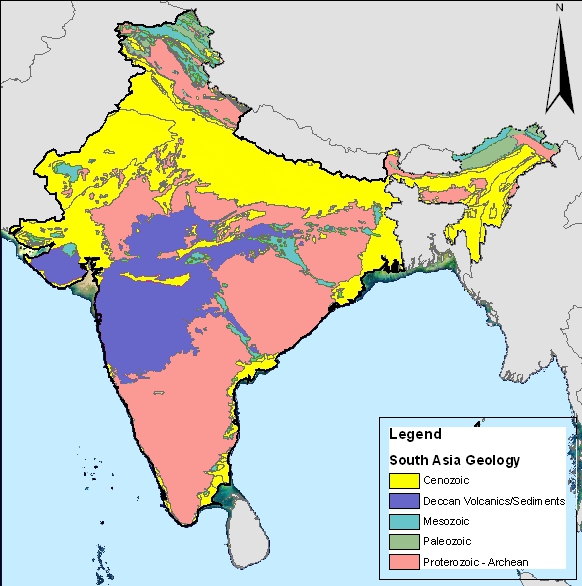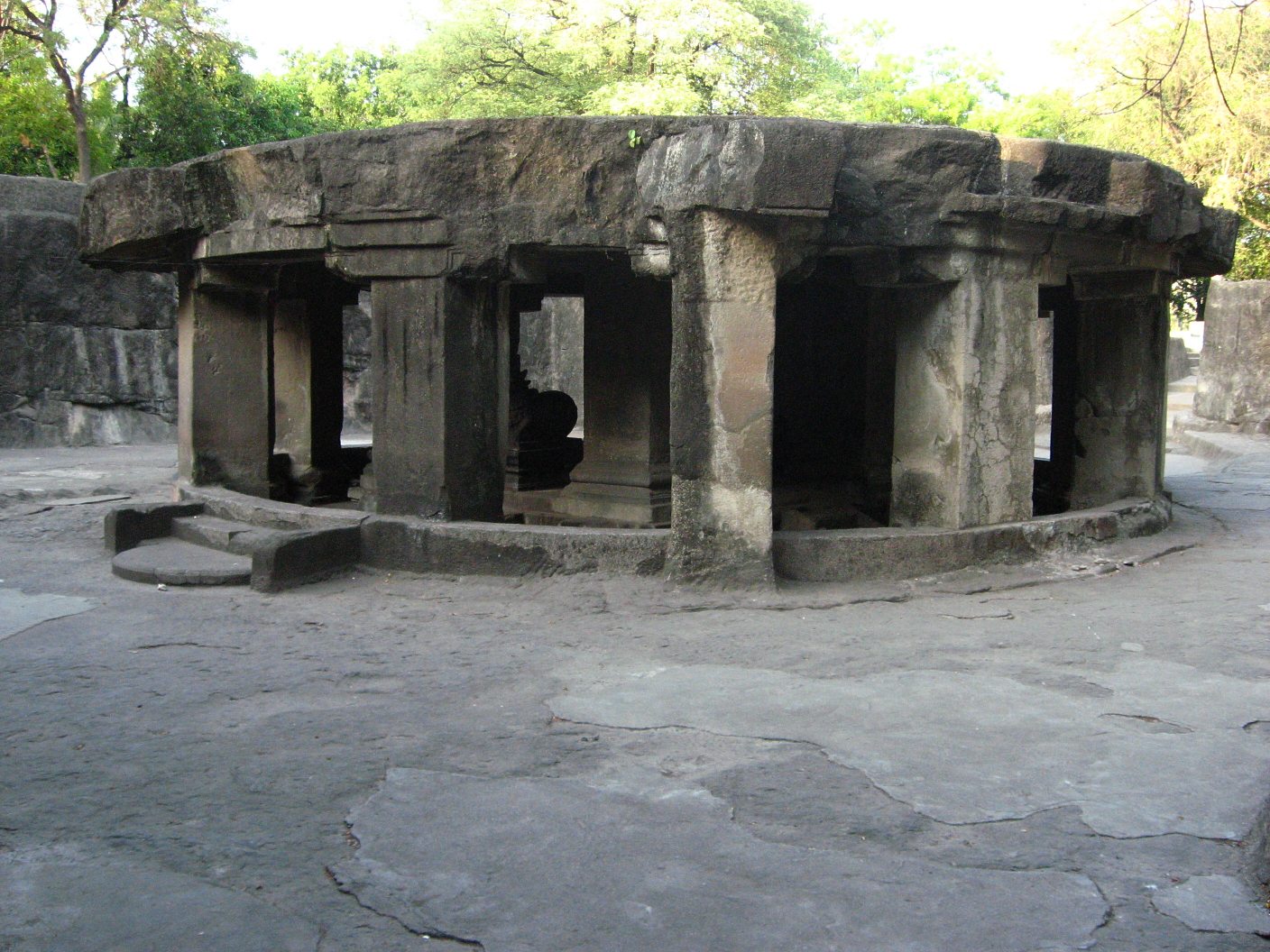|
Ellora Caves
The Ellora Caves are a UNESCO World Heritage Site in Aurangabad, India. It is one of the largest rock-cut cave complexes in the world, with artwork dating from the period 600–1000 AD, including Hindu, Buddhist, and Jain caves., Quote: "These 34 monasteries and temples, extending over more than 2 km, were dug side by side in the wall of a high basalt cliff, not far from Aurangabad, in Maharashtra. Ellora, with its uninterrupted sequence of monuments dating from AD 600 to 1000, brings the civilization of ancient India to life. Not only is the Ellora complex a unique artistic creation and a technological exploit but, with its sanctuaries devoted to Hinduism, it illustrates the spirit of tolerance that was characteristic of ancient India." The complex is a leading example of Indian rock-cut architecture, and several are not strictly "caves" in that they have no roof. Cave 16 features the largest single monolithic rock excavation in the world, the Kailash temple, a chariot-shap ... [...More Info...] [...Related Items...] OR: [Wikipedia] [Google] [Baidu] |
Aurangabad District, Maharashtra
Aurangabad district (Marathi pronunciation: Help:IPA/Marathi, [əu̯ɾəŋɡaːbaːd̪]), officially known as Chhatrapati Sambhajinagar district, is one of the 36 Districts of Maharashtra, districts of the state of Maharashtra in western India. It borders the districts of Nashik District, Nashik to the west, Jalgaon District, Jalgaon to the north, Jalna District, Jalna to the east, and Ahmednagar District, Ahmednagar to the south. Aurangabad, The city of Aurangabad houses the district's administrative headquarters. The district has an area of 10,100 km, of which 37.55% is urban and the rest is rural. Aurangabad District is a Tourism in Marathwada, major tourism region in Marathwada, with attractions including the Ajanta Caves and Ellora Caves. Geography Aurangabad District is located mainly in the Godavari River Basin and partly in the Tapti River Basin. The district is located between 19th parallel north, 19 and 20th parallel north, 20 degrees north longitude and between 7 ... [...More Info...] [...Related Items...] OR: [Wikipedia] [Google] [Baidu] |
Ajanta Caves
The Ajanta Caves are 30 rock-cut architecture, rock-cut Buddhist caves in India, Buddhist cave monuments dating from the second century Common Era, BCE to about 480 CE in Aurangabad district, Maharashtra, Aurangabad district of Maharashtra state in India. Ajanta Caves are a UNESCO World Heritage Site. Universally regarded as masterpieces of Buddhist art, Buddhist religious art, the caves include paintings and rock-cut sculptures described as among the finest surviving examples of Ancient Indian architecture, ancient Indian art, particularly expressive paintings that present emotions through gesture, pose and form. The caves were built in two phases, the first starting around the second century BCE and the second occurring from 400 to 650 CE, according to older accounts, or in a brief period of 460–480 CE according to later scholarship. The Ajanta Caves constitute ancient monasteries (''Vihāra, Viharas'') and worship-halls (''Chaityas'') of different Buddhist traditions car ... [...More Info...] [...Related Items...] OR: [Wikipedia] [Google] [Baidu] |
Traikutakas
The Traikutakas were a dynasty of Indian kings who ruled between 388 and 456. The name "Traikutakas" seems to be derived from the words for a three-peaked mountain ("Tri-kuta"). The Traikutakas are mentioned in Kalidasa's Raghuvamsa, in which they are located in the area of northern Konkan, Kokan. The dominions of the Traikutakas further included Aparanta and northern Maharashtra. The coins of the Traikutaras are found extensively in southern Gujarat, and southern Maharashtra beyond the Ghats. Their design is very close to that of the Western Satraps, from which they probably inherited some territories, and traces of the obverse legend with Greek alphabet, Greek letters can still be seen. History Some scholars theorize that the Traikutakas were a branch of the Abhira dynasty, Abhiras, and refer to them as the "Abhira-Traikutakas". These scholars assume that the Traikutaka records were dated in the so-called Kalachuris of Mahishmati, Chedi-Kalachuri era, starting in 249 CE. Howev ... [...More Info...] [...Related Items...] OR: [Wikipedia] [Google] [Baidu] |
Cretaceous
The Cretaceous ( ) is a geological period that lasted from about 143.1 to 66 mya (unit), million years ago (Mya). It is the third and final period of the Mesozoic Era (geology), Era, as well as the longest. At around 77.1 million years, it is the ninth and longest geological period of the entire Phanerozoic. The name is derived from the Latin , 'chalk', which is abundant in the latter half of the period. It is usually abbreviated K, for its German translation . The Cretaceous was a period with a relatively warm climate, resulting in high Sea level#Local and eustatic, eustatic sea levels that created numerous shallow Inland sea (geology), inland seas. These oceans and seas were populated with now-extinct marine reptiles, ammonites, and rudists, while dinosaurs continued to dominate on land. The world was largely ice-free, although there is some evidence of brief periods of glaciation during the cooler first half, and forests extended to the poles. Many of the dominant taxonomic gr ... [...More Info...] [...Related Items...] OR: [Wikipedia] [Google] [Baidu] |
Deccan Traps
The Deccan Traps are a large igneous province of west-central India (17–24°N, 73–74°E). They are one of the largest volcanic features on Earth, taking the form of a large shield volcano. They consist of many layers of solidified flood basalt that together are more than about thick, cover an area of about , and have a volume of about . Originally, the Deccan Traps may have covered about ,"What really killed the dinosaurs?" Jennifer Chu, MIT News Office, 11 December 2014 with a correspondingly larger original volume. This volume overlies the age Indian Shield, which is ... [...More Info...] [...Related Items...] OR: [Wikipedia] [Google] [Baidu] |
Grishneshwar Temple
Grushneshwar Jyotirlinga is a Hindu temple of Shiva in Verul village of Aurangabad district, Maharashtra, India. It is one of the 12 '' Jyotirlinga'' mandirs. The mandir is a national protected site, one and a half kilometers away from the Ellora Caves, north-west of the city Aurangabad, and east-northeast far from Mumbai. Grushneshwar is mentioned in the ''Shiva Purana'', the ''Skanda Purana'', the ''Ramayana'' and the ''Mahabharata.'' Etymology The word ''Ghrneshwara'' means "lord of compassion". History The temple structure was destroyed by the Delhi Sultanate in 13th and 14th centuries. The temple went through several rounds of rebuilding followed by re-destruction during the Mughal-Maratha conflict. Maloji Bhosale (grandfather of Shivaji) first restored it in the 16th century and rebuilt it to its current form in the year 1729, under the sponsorship of queen Gautama Bai Holkar of Indore, after the fall of the Mughal Empire. It is presently an important and active pil ... [...More Info...] [...Related Items...] OR: [Wikipedia] [Google] [Baidu] |
Pune
Pune ( ; , ISO 15919, ISO: ), previously spelled in English as Poona (List of renamed Indian cities and states#Maharashtra, the official name until 1978), is a city in the state of Maharashtra in the Deccan Plateau, Deccan plateau in Western India. It is the administrative headquarters of the Pune district, and of Pune division. In terms of the total amount of land under its jurisdiction, Pune is the largest city in Maharashtra, with a geographical area of 516.18 sq km, though List of cities in India by population, by population it comes in a distant second to Mumbai. According to the 2011 Census of India, Pune has 7.2 million residents in the metropolitan region, making it the List of metropolitan areas in India, seventh-most populous metropolitan area in India. The city of Pune is part of Pune Metropolitan Region. Pune is one of the largest IT hubs in India. It is also one of the most important Automotive industry in India, automobile and Manufacturing in India, manufacturin ... [...More Info...] [...Related Items...] OR: [Wikipedia] [Google] [Baidu] |
Agastya
Agastya was a revered Indian sage of Hinduism. In the Indian tradition, he is a noted recluse and an influential scholar in diverse languages of the Indian subcontinent. He is regarded in some traditions to be a Chiranjivi. He and his wife Lopamudra are the celebrated authors of hymns 1.165 to 1.191 in the Sanskrit text ''Rigveda'' and other Vedic literature. Agastya is considered to be the father of Siddha medicine. Agastya appears in numerous itihasas and Puranas including the major ''Ramayana'' and ''Mahabharata''. He is one of the seven most revered rishis (the Saptarishi) in the Vedic texts, and is revered as one of the Tamil Siddhar in the Shaivism tradition, who invented an early grammar of the Old Tamil language, Agattiyam, playing a pioneering role in the development of Tampraparniyan medicine and spirituality at Saiva centres in proto-era Sri Lanka and South India. He is also revered in the Puranic literature of Shaktism and Vaishnavism. He is one of the Ind ... [...More Info...] [...Related Items...] OR: [Wikipedia] [Google] [Baidu] |
Ilvala
Ilvala () and Vatapi () are asura brothers in Hindu mythology. They are featured in the Mahabharata, in which their murderous scheme is ended by the sage Agastya. Legend In the Mahabharata, the sage Lomasha narrates the legend of the daityas The daityas () are a race of asuras in Hindu mythology, descended from Kashyapa and his wife, Diti. Prominent members of this race include Hiranyaksha, Hiranyakashipu, and Mahabali, all of whom overran the Bhuloka, earth, and required three of Vi ... called Ilvala and Vatapi to the prince Yudhishthira. The elder of the brothers, Ilvala, is stated to have once begged a Brahmin hermit to grant him a son equal to that of the deity Indra. When the Brahmin refused this request, Ilvala grew angry with him. He turned Vatapi into a lamb or a goat, cooked his meat, and served him to the Brahmin. After the Brahmin had completed his meal, Ilvala called out to his brother by name, who promptly emerged from within the Brahmin's side, murdering him. Il ... [...More Info...] [...Related Items...] OR: [Wikipedia] [Google] [Baidu] |






